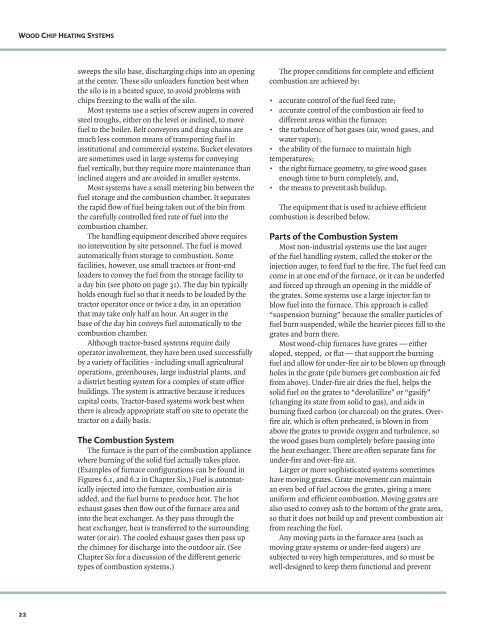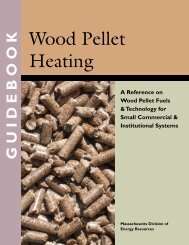Wood-Chip Heating Systems - Biomass Energy Resource Center
Wood-Chip Heating Systems - Biomass Energy Resource Center
Wood-Chip Heating Systems - Biomass Energy Resource Center
Create successful ePaper yourself
Turn your PDF publications into a flip-book with our unique Google optimized e-Paper software.
WOOD CHIP HEATING SYSTEMS<br />
22<br />
sweeps the silo base, discharging chips into an opening<br />
at the center. These silo unloaders function best when<br />
the silo is in a heated space, to avoid problems with<br />
chips freezing to the walls of the silo.<br />
Most systems use a series of screw augers in covered<br />
steel troughs, either on the level or inclined, to move<br />
fuel to the boiler. Belt conveyors and drag chains are<br />
much less common means of transporting fuel in<br />
institutional and commercial systems. Bucket elevators<br />
are sometimes used in large systems for conveying<br />
fuel vertically, but they require more maintenance than<br />
inclined augers and are avoided in smaller systems.<br />
Most systems have a small metering bin between the<br />
fuel storage and the combustion chamber. It separates<br />
the rapid fl ow of fuel being taken out of the bin from<br />
the carefully controlled feed rate of fuel into the<br />
combustion chamber.<br />
The handling equipment described above requires<br />
no intervention by site personnel. The fuel is moved<br />
automatically from storage to combustion. Some<br />
facilities, however, use small tractors or front-end<br />
loaders to convey the fuel from the storage facility to<br />
a day bin (see photo on page 31). The day bin typically<br />
holds enough fuel so that it needs to be loaded by the<br />
tractor operator once or twice a day, in an operation<br />
that may take only half an hour. An auger in the<br />
base of the day bin conveys fuel automatically to the<br />
combustion chamber.<br />
Although tractor-based systems require daily<br />
operator involvement, they have been used successfully<br />
by a variety of facilities - including small agricultural<br />
operations, greenhouses, large industrial plants, and<br />
a district heating system for a complex of state offi ce<br />
buildings. The system is attractive because it reduces<br />
capital costs. Tractor-based systems work best when<br />
there is already appropriate staff on site to operate the<br />
tractor on a daily basis.<br />
The Combustion System<br />
The furnace is the part of the combustion appliance<br />
where burning of the solid fuel actually takes place.<br />
(Examples of furnace confi gurations can be found in<br />
Figures 6.1, and 6.2 in Chapter Six.) Fuel is automatically<br />
injected into the furnace, combustion air is<br />
added, and the fuel burns to produce heat. The hot<br />
exhaust gases then fl ow out of the furnace area and<br />
into the heat exchanger. As they pass through the<br />
heat exchanger, heat is transferred to the surrounding<br />
water (or air). The cooled exhaust gases then pass up<br />
the chimney for discharge into the outdoor air. (See<br />
Chapter Six for a discussion of the different generic<br />
types of combustion systems.)<br />
The proper conditions for complete and effi cient<br />
combustion are achieved by:<br />
• accurate control of the fuel feed rate;<br />
• accurate control of the combustion air feed to<br />
different areas within the furnace;<br />
• the turbulence of hot gases (air, wood gases, and<br />
water vapor);<br />
• the ability of the furnace to maintain high<br />
temperatures;<br />
• the right furnace geometry, to give wood gases<br />
enough time to burn completely, and,<br />
• the means to prevent ash buildup.<br />
The equipment that is used to achieve effi cient<br />
combustion is described below.<br />
Parts of the Combustion System<br />
Most non-industrial systems use the last auger<br />
of the fuel handling system, called the stoker or the<br />
injection auger, to feed fuel to the fi re. The fuel feed can<br />
come in at one end of the furnace, or it can be underfed<br />
and forced up through an opening in the middle of<br />
the grates. Some systems use a large injector fan to<br />
blow fuel into the furnace. This approach is called<br />
“suspension burning” because the smaller particles of<br />
fuel burn suspended, while the heavier pieces fall to the<br />
grates and burn there.<br />
Most wood-chip furnaces have grates — either<br />
sloped, stepped, or fl at — that support the burning<br />
fuel and allow for under-fi re air to be blown up through<br />
holes in the grate (pile burners get combustion air fed<br />
from above). Under-fi re air dries the fuel, helps the<br />
solid fuel on the grates to “devolatilize” or “gasify”<br />
(changing its state from solid to gas), and aids in<br />
burning fi xed carbon (or charcoal) on the grates. Overfi<br />
re air, which is often preheated, is blown in from<br />
above the grates to provide oxygen and turbulence, so<br />
the wood gases burn completely before passing into<br />
the heat exchanger. There are often separate fans for<br />
under-fi re and over-fi re air.<br />
Larger or more sophisticated systems sometimes<br />
have moving grates. Grate movement can maintain<br />
an even bed of fuel across the grates, giving a more<br />
uniform and effi cient combustion. Moving grates are<br />
also used to convey ash to the bottom of the grate area,<br />
so that it does not build up and prevent combustion air<br />
from reaching the fuel.<br />
Any moving parts in the furnace area (such as<br />
moving grate systems or under-feed augers) are<br />
subjected to very high temperatures, and so must be<br />
well-designed to keep them functional and prevent





